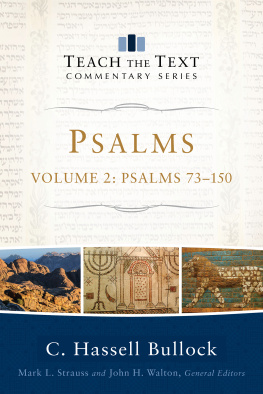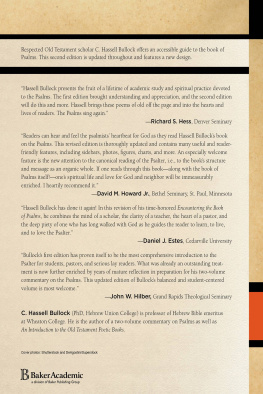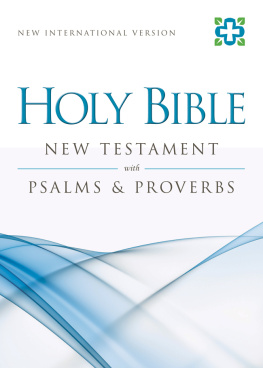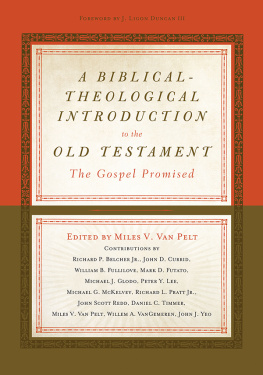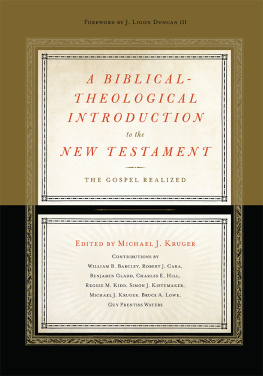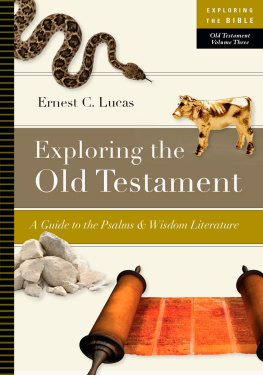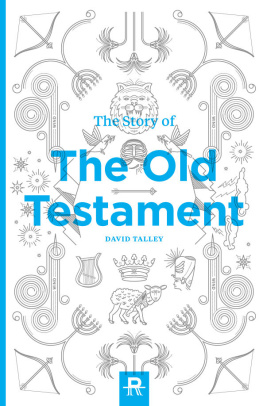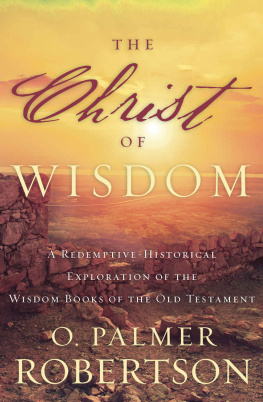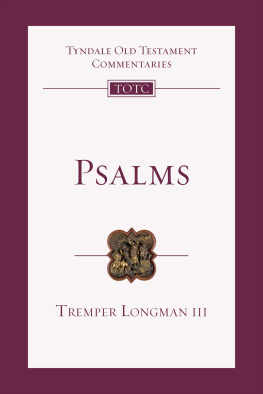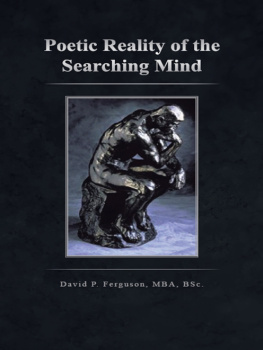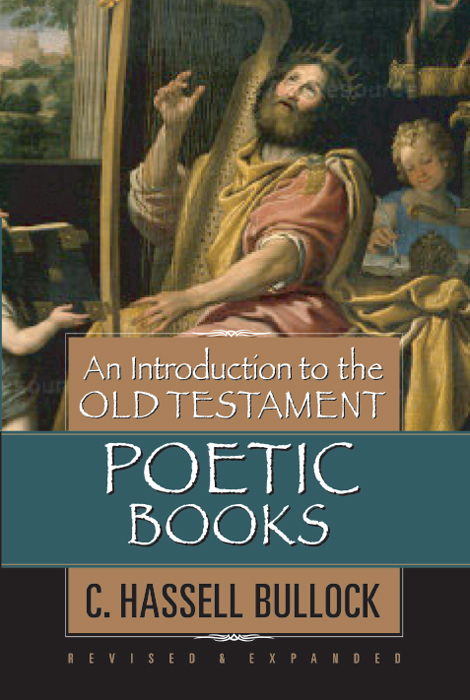AN INTRODUCTION TO THE
OLD TESTAMENT
POETIC
BOOKS
R EVISED AND E XPANDED
C. HASSELL BULLOCK
M OODY P UBLISHERS
CHICAGO
1979, 1988 by
C. H ASSELL B ULLOCK
All rights reserved. No part of this book may be reproduced in any form without permission in writing from the publisher, except in the case of brief quotations embodied in critical articles or reviews.
All Scripture quotations, unless otherwise indicated, are taken from the New American Standard Bible, Copyright 1960, 1962, 1963, 1968, 1971, 1972, 1973, 1975, 1977 by The Lockman Foundation. Used by permission. (www.Lockman.org)
Scripture quotations marked KJV are taken from the King James Version.
Scripture quotations marked RSV are from the Revised Standard Version of the Bible, copyright 1952 [2nd edition, 1971] by the Division of Christian Education of the National Council of the Churches of Christ in the USA. Used by permission. All rights reserved.
The use of selected references from various versions of the Bible in this publication does not necessarily imply publisher endorsement of the versions in their entirety.
The standard used for Hebrew transliteration is the system presented by J. Weingreen, Practical Grammar for Classical Hebrew, 2d. ed. (Oxford: Clarendon, 1959), pp. 1, 4.
| Interior Design: | Ragont Design |
| Cover Design: | PaetzoldSedlacek, LLD (www.paetzolddesign.com) |
| Cover Images: | Art Source
Domenichino (1581-1641)
King David playing the harp. Oil on canvas, 241 171 cm.
Photo: Daniel Arnaudet.
Chateaux de Versailles et de Trianon, Versailles, France
Photo Credit: Runion des Muses Nationaux / Art Resource, NY |
Library of Congress Cataloging in Publication
Bullock, C. Hassell.
An introduction to the Old Testament poetic books / by C. Hassell Bullock.Rev. and expanded.
p. cm.
Bibliography: p.
Includes indexes.
ISBN: 0-8024-4157-2
ISBN-13: 978-0-8024-4157-7
1. Bible. O.T.Criticism, interpretation, etc. 2. Hebrew poetry, BiblicalHistory and criticism. 3. Wisdom literatureHistory and criticism. I. Title.
BS1405.2.B84 1988
223.061dc19
88-15300
CIP
We hope you enjoy this book from Moody Publishers. Our goal is to provide high-quality, thought-provoking books and products that connect truth to your real needs and challenges. For more information on other books and products written and produced from a biblical perspective, go to www.moodypublishers.com or write to:
Moody Publishers
820 N. LaSalle Boulevard
Chicago, IL 60610
1 3 5 7 9 10 8 6 4 2
Printed in the United States of America
To Rhonda
her worth is far above jewels.
(Prov. 31:10)
CONTENTS
PREFACE TO THE
SECOND EDITION
T o all of those who have used the first edition of this book I express my sincere appreciation. Learning is progressive, and the intervening years since the books publication have been a time of thinking and rethinking the contents of this work. While I have not made substantive changes in the format, except for the two introductory chapters, nor have I substantially altered many of the ideas contained in it, I have attempted to sharpen some of them as a result of my ongoing experience in the setting of a college classroom and of an active life in the world and the church. A sense of the power of this literature has continued to grow in me, and I am more convinced than ever that if studied and applied seriously to modern life, its effect will be no less than transforming. That remains the goal of this book, even though its purpose is largely academic. My discussion of wisdom and the Psalms in chapter 2 is an attempt to apply the theology of this material to modern life.
In all honesty, I would like to acknowledge that my thinking on a few matters has not yet matured to the point that I can say, Here I stand. I am not hesitant to call attention to the Song of Songs, where I have allowed the literal interpretation (including my satirical interpretation) to stand. Yet, while I have on the one hand tried to take into account the recent studies of the Egyptian love songs and their importance for the Song, I have opened the door wider to the allegorical method in deference to two thousand years of interpretation, including its significance for the canonization of that book.
Books are never really finished, I suppose, and that is a good reason to issue a revised edition. Those who have studied the Talmud know that every new tractate begins on page two. An old explanation of this practice is that it reminds us from the beginning that no one will ever know it all. If the midrashic method can still be permitted (how impoverished we would be without it!), I might suggest that the frequent practice of publishers to bind blank pages at the end of a book can be a reminder, quite unintended, of course, that there is no end of knowledge. Much yet remains to be learned and written. I submit this revised edition as another stage in that process.
I wish to thank Moody Publishers, particularly Messrs. Garry Knussman and Dana Gould, for permitting and encouraging this revised edition, as well as the editorial staff who have worked so congenially with me in the past. Special thanks is due to Mr. Robert Ramey, whose conscientious editing of this revised edition has contributed many improvements to it. Appreciation is also appropriate to Miss Valori Hughes, my teachers assistant, who has helped me complete this task. Finally, I offer thanks to Mr. Don Patrick who, as loyal friend and expert bibliographer, has assisted my research and collected the bibliography for this volume.
And to God be the glory!
PREFACE TO THE
FIRST EDITION
T he teacher and student share a mutual and complementary relationship quite unlike any other. Qheleth expressed it wellthe teachers words are like goads, whereas the students who master them are like well-driven nails (Eccles. 12:11). If the astute teacher seeks to prick the conscience and pry open the mind of his students, it is only in the interest of producing a more stable and productive life. A more stable individual ultimately means a more stable society. The wisdom teachers, therefore, began with the smallest social unit, the individual, and sought to transmit their thought to the wider spectrum of the social order. Motivated by the fear of the Lord, and driven by the desire to understand human life and live in harmony with the world, the wisdom sages engaged both mind and heart in the effort to comprehend.
This special teacher-student relationship, exemplified so beautifully in the ancient wisdom schools, has both motivated and nurtured the effort here represented. Sharing, it is hoped, the motivation and compulsion of the wisdom teachers, I undertook the task of writing a volume that would both introduce the five poetic books, only three of which are technically wisdom literature (Job, Proverbs, Ecclesiastes), and also provide significant guidelines for interpretation. Therefore, in addition to the standard introductory matters, I have devoted several pages to hermeneutical issues on each book and provided an analysis of the book itself to guide the student through the material. This analysis in no way is intended to substitute for the commentary and broader treatment of each book. Rather it is designed to provide the reader with an ingress to the biblical books and the secondary literature on them. Further, the introduction to this volume includes an extended discussion of the cognate literature in the ancient Near East in order to set the biblical material in its literary context. If the nonoriented student at first finds that section laborious, he should come to a greater appreciation as the study takes shape.


